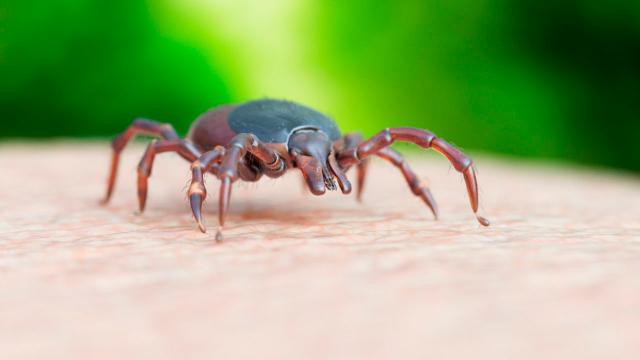Summer in Australia can be a rough time. There’s the blistering heat and the bushfire risks, for one. Then on top of that, it seems all the bugs we’d like to pretend don’t exist like to come out to play, too.
The summer months are a time of mozzies, spiders and apparently ticks, too.
As The Guardian has reported, the American Society of Tropical Medicine and Hygiene (ASTMH) completed a recent study that assessed the behaviour of ticks during warmer weather. The research looked at whether ticks tend to latch on to humans or dogs in higher temperatures. Interestingly, the study found that when temperatures were raised from 23.3C to 37.8C “brown dog ticks” often went for humans.
Seeing that we are in the middle of Summer and many Aussies are keen to get exploring the great outdoors, I figured it would be useful to look a little closer into this information and what it means.
First of all, what’s a tick?
According to NSW Health, “Ticks are parasites that feed on the animal and human blood”. They tend to appear in “humid, moist bushy areas” and they tend to latch onto animals and humans, in which case they are able to “inject toxins” into the skin.
It’s been reported that in most cases, tick bites have few symptoms. Occasionally the bite will become irritated, but the real concern is the diseases that some ticks carry.
What can happen if you’re bitten by a tick?
Laura Backus, who led the study referenced by The Guardian, is quoted sharing that the study highlights folks need to be more cautious of tick-related illnesses in summer. The brown dog ticks featured in the study were known to carry Rocky Mountain spotted fever (RMSF) disease, and “were 2.5 times more likely to prefer humans over dogs”.
NSW Health has shared on its website that in Australia, tick-borne diseases are: “Australian Tick Typhus or ‘Spotted Fever’ (along the coastal strip of eastern Australia from North Queensland to Victoria) and ‘Flinders Island Spotted Fever’ (in Victoria, Tasmania and Flinders Island in Bass Strait)”.
“Early symptoms of tick paralysis can include rashes, headache, fever, flu like symptoms, tenderness of lymph nodes, unsteady gait, intolerance to bright light, increased weakness of the limbs and partial facial paralysis.”
Other allergic reactions have been reported, some as severe as life-threatening anaphylaxis.
As the ABC has shared, there is also an understanding that tick bites can lead to Mammalian Meat Allergy (MMA); a condition that leads to allergies to red meat.
How can I prevent a tick bite during summer?
The best move here is to be aware of tick-infested areas and steer clear of them. So, particularly humid, bushy areas are ones to look out for.
If you’re expecting to step into a tick-infested area, the Australian Department of Health recommends using a diethyl-meta-toluamide (DEET) based insect repellent, along with permethrin-treated clothes (which they state can be found at adventure stores).
It’s also suggested that you wear long-sleeved shirts and long pants, with your trousers tucked into your socks. And light-coloured clothing is also a good move, as it makes it easier to spot ticks.
Lastly, it’s recommended you toss all your clothes into a hot dryer after visiting a tick-infested area – that should kill any ticks that may have hopped onto your gear while out.
How to get rid of a tick:
If you should be unlucky and find yourself bitten by a tick (be sure to check yourselves for them whenever returning home from hotspots), here’s what you should do.
According to the Australian Department of Health, people who have had allergic reactions to ticks should go straight to a medical facility or emergency department.
In other cases, it’s advised that you attempt “removing a tick with fine-tipped forceps (not household tweezers), grasp the tick as close to the skin’s surface as possible. Pull upwards with steady pressure and avoid jerking or twisting the tick”.
If you’re having trouble, just call it a day and visit a medical professional. It’s important not to squeeze ticks as that can inject more toxins into your body.
Other tips from the Department of Health regarding ticks (in summer especially) include:
“Don’t use folklore remedies such as matches or pins because they will irritate the tick and make it harder to completely remove,” and “avoid scratching and do not use irritant chemicals such as methylated spirits or kerosene”.
TiARA (Tick-induced Allergies Research and Awareness) has produced a video detailing the best way to manage ticks.
According to the TiARA team, the best approach is to avoid scratching anything you can’t see (just in case it’s a tick); do your best to avoid disturbing ticks “because she’ll squirt allergen into you”; “freeze it don’t squeeze it” (detailed in the above video), and “kill the tick where it is” (also detailed in the above video). Much like the Department of Health, TiARA has stated household tweezers should not be used in attempted removals of ticks.
Best of luck out there, friends.
This article has been updated since its original publish date.

Leave a Reply
You must be logged in to post a comment.